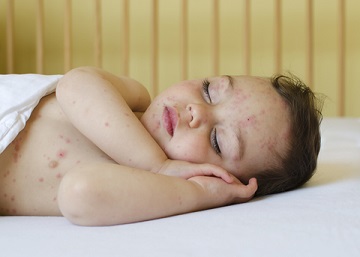In tropical regions, chickenpox (or varicella) is a disease affecting older children or adults that’s more likely to strike during the ‘tourist’ season when it’s dry and the temperatures are cooler. For temperate climates, which most Australians live in, spikes of infection occur mostly in winter or spring1.
Proof indeed!
Before the chickenpox (varicella) vaccine was introduced into our national immunisation program in 2005 (a single dose was given to children under 14 years of age), each year over 200,000 cases of chickenpox were reported and around 1,500 of those needed hospitalisation. Even worse, an average of 7 deaths annually resulted2. Now, some 11 years later, that annual number of cases is now around 2,4003, and the greatest benefit has been seen in children aged 1-4 years and indigenous Australians4.
The USA added the vaccine to its routine vaccination program in 1996 in response to an estimated 4 million chickenpox cases each year, including 11,000 to 13,500 hospitalisations and 100 to 150 chickenpox-related deaths. The result was an astounding 85% reduction in the incidence of chickenpox. However because of continued outbreaks in schools and high rates of ‘breakthrough’ infections among immunised children3, a second dose was included in the routine childhood immunisation schedule in 2006. The National Notifiable Diseases Surveillance System has since documented an overall 97% reduction in the incidence of chickenpox since the varicella vaccination program was implemented5.
What do we do next?
Leading Australian immunisation resources, the Australian Technical Advisory Group on Immunisation (ATAGI) and the National Health and Medical Research Council (NHMRC), through the Australian Immunisation Handbook, have recommended a second vaccine dose as it provides protection similar to that of natural infection, adds to herd immunity and minimises the chance of breakthrough infection in children under 14 years of age, but acknowledge that the lack of funding means that it must be paid for by parents and carers privately.
The disease
Varicella-Zoster Virus (VZV), better known as chickenpox, is one of eight herpes viruses that can cause infection in humans and it’s highly contagious - up to 90% of household contacts will develop the disease. The virus is transmitted via the upper respiratory tract by aerosol spread of infected respiratory secretions or contact with the vesicular fluid from those infected. There is a 10 to 21 day incubation period and infected individuals are contagious from 2 days before the onset of the typical vesicular rash until all the rash vesicles are crusted. Typically the illness commences with a prodromal phase with symptoms such as fever, malaise. 1-2 days later the typical itchy, blister-like rash begins to appear. Initially the blisters (vesicles) affect the trunk and face and then spread to the rest of the body. Each vesicle has a red base which develops into a pustule that eventually forms a crust. New vesicles continue to appear for 3 to 7 days, with an average of 300 lesions (but can number from 10 up to 1,500).
Some 5% of children exposed actually get subclinical infections with subsequent immunity without knowing that they had contracted the infection.
Serious complications of acute varicella infection are rare, occurring in approximately 1% of cases. These may present as secondary bacterial infections of the skin lesions, pneumonia, encephalitis and hepatitis. Infection is usually more severe in adolescents and adults2. Following infection, antibodies are produced which will keep the virus at bay; however as we age, we become more susceptible and the virus can emerge and cause the painful herpes zoster infection, also known as shingles.
Vaccines: What we have and who do we give it to?
In Australia there are 2 vaccines containing live, attenuated varicella zoster virus, plus 2 others used only in children that are in combination with measles, mumps and rubella.
While not publicly funded, varicella vaccination is also recommended for non-immune adults at high risk of developing the disease: healthcare professionals, child-care workers, non-immune women prior to falling pregnant and parents. Also, household contacts with no immunity should be vaccinated to prevent the virus’ spread to immunosuppressed individuals. The vaccine schedule for the 14 years and older age group is 2 doses administered at least 4 weeks apart. An important note is that varicella-containing vaccines are contraindicated for pregnant women and pregnancy should be avoided for at least 28 days after vaccination.
If you’re travelling overseas
The risk of chickenpox is as high in developed countries as in developing ones. Very few countries include the vaccine in their routine childhood schedules - Canada, Costa Rica, Germany, Greece, Korea, Latvia, Luxembourg, Qatar, Saudi Arabia, UAE, Uruguay, USA and some parts of Spain & Italy1 - but coverage is increasing. Non-immune adults and children should consider vaccination, especially if planning longer stays or extensive travel.
1. http://wwwnc.cdc.gov/travel/yellowbook/2016/infectious-diseases-related-to-travel/varicella-chickenpox
2. http://www.ncirs.edu.au/assets/provider_resources/fact-sheets/varicella-fact-sheet.pdf
3. http://www9.health.gov.au/cda/source/rpt_3.cfm
4. http://www.who.int/bulletin/volumes/92/8/13-132142.pdf?ua=1%20A
5. http://www.cdc.gov/mmwr/preview/mmwrhtml/rr5604a1.htm

